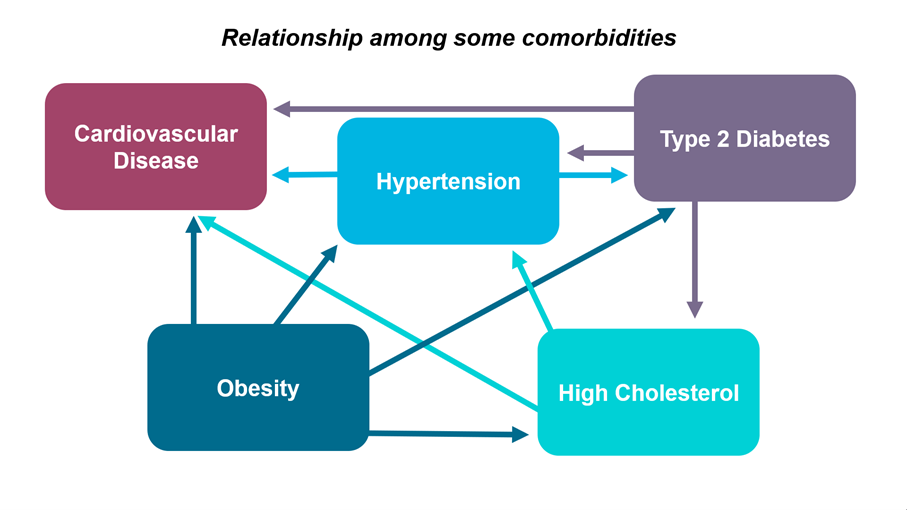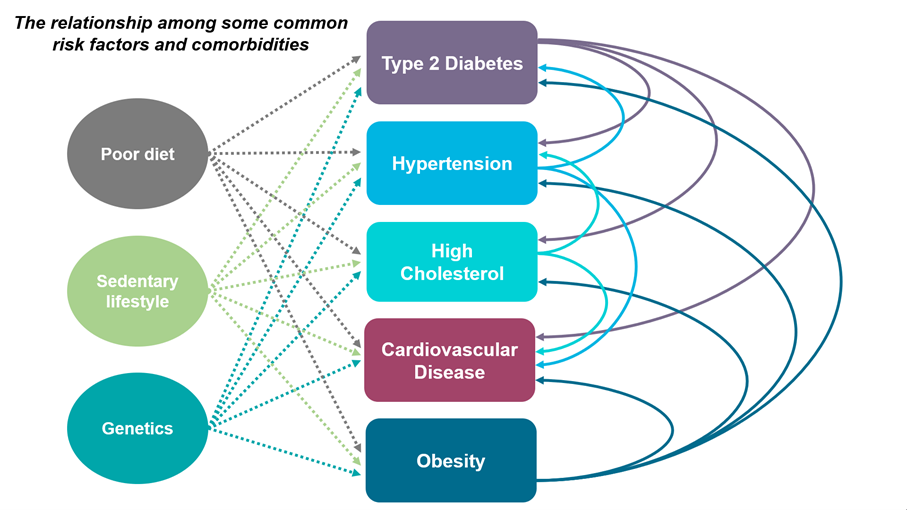Demystifying health risks and comorbidities
Awareness, prevention, and proactive management are key
February 9, 2022

SCOR Global Life is dedicated to helping people live longer, healthier lives. The first step toward accomplishing this goal is to ensure people are aware of health risks and how to prevent them.
In this article our medical experts discuss common modifiable and non-modifiable risk factors, comorbidities, and the lifestyle changes that can help mitigate these risks and complications. We then turn to our underwriting team to understand the role these risks play in providing insurance coverage at a fair price.
What is a risk factor?
A risk factor is a trait, characteristic, or behavior that increases a person’s likelihood of developing a disease. Risk factors can be either modifiable or non-modifiable. Controlling modifiable risks often comes down to committing to a healthier lifestyle and can be key to reducing your chances of developing chronic health conditions like type 2 diabetes, cardiovascular disease, and certain cancers.
Common modifiable risk factors
- Smoking: Smoking is responsible for as much as 90% of lung cancers, and can lead to heart disease, stroke, lung diseases, diabetes, and chronic obstructive pulmonary disease (COPD). ,
- Sedentary lifestyle: A sedentary lifestyle increases all causes of mortality, doubling the risk of developing cardiovascular diseases, diabetes, and obesity and increasing the risks of colon cancer, high blood pressure, osteoporosis, lipid disorders, depression, and anxiety.
- Poor diet: An unhealthy diet can lead to obesity, cardiovascular diseases, cancer, and diabetes, and more. ,
- Drug and alcohol consumption: Drug and alcohol abuse can have long-lasting health complications, leading to abnormal heart rate and an increased risk of heart attack, cancer, and other health concerns.
Common non-modifiable risk factors:
- Age: Aging is one of the most important risk factors when it comes to developing certain cancers, cardiovascular disease, and neurodegenerative conditions.
- Sex: Some diseases occur exclusively or predominantly in women (breast cancer, endometriosis, etc.) or in men (prostate cancer). Men are twice as likely to experience a heart attack than women and at a younger age, while women are more likely to suffer from a stroke.
- Genetics: Knowing that certain diseases run in the family means that you can take precautions, make lifestyle changes, and schedule early screenings to prevent developing or to detect these conditions before they become serious.
What is a comorbidity?
More often than not, risk factors can increase the chance of developing several distinctive health conditions. However, simply having two conditions at the same time doesn’t necessarily mean you have comorbidities.
The term “comorbidity” indicates that a patient has developed two distinct health conditions that:
- Exacerbate the severity of each other
- Can impact the management and treatment of the other condition
- Together increase the risk of mortality
If we consider someone who develops both type 2 diabetes and eczema, the conditions would not be considered comorbidities as they don’t have a direct impact on each other. However, if that same person also developed depression, their diabetes and depression would be considered comorbidities since depression has been shown to hinder the management of diabetes. In this case, having diabetes might be a contributing factor to the development of depression, but this is not always the case. Comorbidities can also develop independently of each other. The relationship among comorbidities can be complex and certain diseases are strongly correlated because the outcome of one disease can be the cause of another. This is particularly apparent when considering the relationship among cardiovascular disease, type 2 diabetes, hypertension, high cholesterol, and obesity (see image below). In this case, each of the comorbidities can develop as a direct result of a single original condition (such as obesity).
What is the relationship between risk factors and comorbidities?
When considering the relationship among risk factors and comorbidities, things get even more complicated. As we have seen, each risk factor has the potential to lead to many different conditions. Each of these conditions, in turn, has the potential to cause or worsen another condition.
The diagram above offers insights into the complexity of managing multiple comorbidities: if any one of these conditions is not well-controlled, it is likely to lead to a worsening of another of the existing conditions. This is the difficulty in managing metabolic syndrome, for example.
While chronic medical conditions tend to occur in clusters, it is important to understand that having these risk factors is not a guarantee that you will develop any or several of these diseases. Nor does developing one or more mean that you will inevitably develop all possible related diseases. Some people who manage their type 2 diabetes well may never develop cardiovascular disease. Other people may develop cardiovascular disease, but not diabetes.
That is why understanding your risk factors, seeking advice from your doctor, taking preventative measures, and proactively managing existing chronic conditions is so important to prevent further complications.
Treatment and prevention of comorbidities
The first steps to reducing the potential impact of modifiable risk factors are recognizing your risk factors and taking steps to lead a healthy lifestyle. Stop smoking. Incorporate physical activities into your daily routine and cut back on high-fat, high-sodium, and high-calorie foods. Being aware of your non-modifiable risks and proactively discussing these risks and potential screenings or preventative measures with your doctor can help you avoid serious complication in the long run.
If you do develop a chronic condition, discuss with your doctor how to best manage it to reduce your chances of developing a comorbidity or further complications. Even after developing comorbidities, committing to more exercise and a healthier diet can help alleviate the symptoms and the severity of these chronic conditions and remains an important step in ongoing health management.
The insurance angle
Historically, insurance companies have reached their underwriting decisions by applying a conservative evidence-based approach and erring on the side of caution, meaning if they were unable to identify the risk represented by an applicant, they would often apply a loading, an exclusion (if for Critical Illness or Disability) or deny coverage altogether. For example, an applicant who is obese and suffers from uncontrolled type 2 diabetes or hypertension would present significantly higher risks to insurers than a healthy applicant all else being equal and therefore would likely be offered coverage with a loading fee incorporated into the premium or a policy with certain exclusions.
While this approach may have made sense from a short- to medium-term business perspective, at SCOR our goal is to continue to apply the fairest terms possible in the interest of the policyholder. This will in turn help to close the protection gap and ensure that underinsured and uninsured populations have access to the protection they need. To accomplish this, SCOR is pioneering a new approach to more accurate risk calculation with our line of Vitae risk calculators. Harnessing the most recent data and medical insights and using an algorithm that better correlates the impact of multiple risks, our Vitae Cardio risk calculator can offer new precision when an applicant has several identified risk factors or comorbidities. This and other Vitae calculators enable insurers to more accurately gauge risks declared by an applicant in order to offer more inclusive coverage to more people at fairer prices.
We are also working toward a more resilient future by helping insureds stay healthy and manage their chronic conditions by capitalizing on recent innovations and insurtech capabilities that provide tools to improve health and wellness for both applicants and in-force policyholders.

